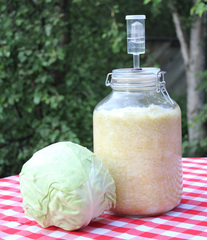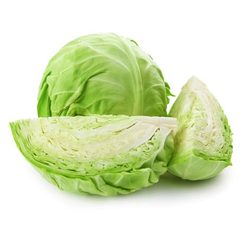
A favorite addition to sauerkraut is caraway seed. Whole caraway seed adds a wonderful flavor to sauerkraut, but use sparingly ~ A little goes a long way! Be sure the seeds are whole and not powdered. Ground spices harbor more mold and can contribute to spoilage in a new ferment.
Ingredients: Cored and finely sliced cabbage (food processor or mandolin on narrowest slicing setting) Optional: ¼ tsp. whole caraway seed/pound cabbage Jar: Recommend 2 to 5 liter Jar Brine: Self-brining Ferment: 8-10 days active, 2-3 months total 
Preparation:
49 Comments
Traci
12/15/2014 06:48:37 am
My sauerkraut has been fermenting for 4 days. The juices keep filling up the air lock and leaking out. I followed your video instructions and changed the air lock each time it has overflowed. Should I keep doing this or should I now open the jar and pack it down?
Reply
Karen
5/29/2015 11:49:19 pm
Hi Traci,
Reply
Phyllis Corella
5/29/2015 07:57:34 pm
Traci, I see no one replied. What did you end up doing, and how was your sauerkraut? Phyllis
Reply
Merry Hansen
6/5/2015 06:20:23 am
Do we remove the airlock when we move it to the fridge? And place the plug in the grommet?
Reply
The Probiotic Jar
7/7/2015 12:14:43 pm
No, most ferments continue to produce gasses in the refrigerator. The fermenting doesn't completely finish on the counter ~ with cabbage, especially, it takes 3 months total before it is thoroughly fermented and ready to eat. As long as there is food in the Jar, we leave the Airlock on it. There are several benefits to this: 1. No pressure buildup causing harm to the Lactic Acid Bacteria. 2. The forming gasses continue to expel the oxygen from the Jar, lengthening the shelf life. If you use a stopper, you not only will have some pressure buildup, but the introduced oxygen every time you're opening the Jar while consuming the finished ferment will feed the molds and yeasts that are introduced when opening it as well. As long as you don't open it, or let the Airlock dry out, you can expect the cabbage to last. I have some that is two years old, and still wonderful. Once you open the Jar, the clock on spoilage starts ticking, and if you keep the Airlock on, you can expect 4-6 months of shelf life, or without...only 2-3 months. With cabbage. Each food is a little different. :)
Reply
Patrick
7/4/2015 09:10:36 pm
Karen: I don't understand this part of your sauerkraut recipe:
Reply
Merry Hansen
7/4/2015 11:28:12 pm
Hi Patrick. I believe Karen is talking about the size of the jar. So if you are going to use a one-liter jar, you will use approx. 2 pounds of cabbage. I'm sure Karen will verify this.
Reply
Karen
7/7/2015 12:15:40 pm
Merry got it exactly right!!! :) We put this in there just to help you plan your cabbage and Jar. Sorry that it wasn't clear!
Reply
Patrick
7/10/2015 11:40:39 am
Well that is a good segway to another question. Bear with me. I have a 2 qt jar & only 1 qt of cabbage. I'm using an airlock. Is that vacant space in the jar ..... A problem?
Reply
The Probiotic Jar
7/10/2015 01:45:48 pm
Hi Patrick...yes, definitely! You can't leave all that air space; it will take far too long for the oxygen to get used up and expelled, and it won't be an optimized anaerobic ferment.
Reply
Rachel
7/16/2015 08:22:29 am
I hooked up with Probiotic Jar website and I have to say I am totally
Reply
Meredith
1/13/2016 04:06:29 am
I have sauerkraut continuing to ferment in the refrigerator, with the airlock on and filled, for about 2 months now. My goal was to let it go the entire 11 weeks. When I put it in the fridge, the brine was immersing all of the cabbage. Now it looks as though about half has dried. Would you recommend I open the jar to refill with brine or will the unimmersed kraut continue to ferment without doing so? Just want to ensure I have good kraut after all the work :) Thanks!
Reply
Hi Meredith,
Reply
Greg Horwitz
9/6/2016 08:38:22 pm
Hi, I'm new at this and have been waiting for the chance to make sauerkraut. Now that I have I've run into the same problem with the expanding kraut.
Reply
Karen
9/6/2016 08:42:01 pm
Hello Greg,
Reply
Chuck
11/18/2016 04:04:48 am
Hello, in step 3 of the preparation, it advises to wait an hour to evaluate brine level. Are we waiting with a sealed top or is the jar still open during this waiting period?
Reply
Karen
11/18/2016 11:06:27 am
Hello Chuck,
Reply
Annie
12/29/2016 11:52:46 pm
I can't find any recipe for kimchi... can I use this for making kimchi?
Reply
12/30/2016 08:45:55 am
Hello Annie,
Reply
Annie
1/7/2017 10:50:33 pm
Hi Karen, I'm going to use only cabbage, salt and pepper for Kimchi. Will this work? How much salt would you recommend? You mentioned dried spices - does that include pepper as well? Thanks!
Hi Annie,
Annie
1/11/2017 03:11:45 pm
Hi Karen,
Angie Hepp
1/7/2017 02:28:17 pm
I have made this recipe a dozen times and love it! Thank you! One question...I have tried (unsuccessfully) to grow cabbage organically. How did you manage to grow your own cabbage without it being riddled with worms? Any tips would be most appreciated!
Reply
1/7/2017 04:21:02 pm
H Angie Hepp!
Reply
Angie Hepp
2/8/2017 01:39:16 pm
Thank you so much! We don't have slug problems, for us it's a small white moth that lays eggs that turn into worms that destroy the cabbage (and broccoli and pretty much any crucifer.) :( I'm thinking I may have to do row covers.
Louise
2/13/2017 05:38:17 pm
Hi Karen,
Reply
Karen Ross
2/13/2017 09:08:26 pm
Hi Louise,
Reply
michael allen
3/30/2017 01:41:26 pm
last year i made this without any problems fermented for 8 months at 55 degrees before moving to fridge this year i noticed the water in airlock was quite low and cabbage at top of jar is moldy is it safe to scrape off and eat the rest?
Reply
Karen
3/30/2017 02:37:54 pm
Hello Michael,
Reply
8/15/2017 10:30:03 am
I've never used carraway seeds before with kraut. Thanks so much for sharing! Very interested in giving this recipe a shot the next time I decide to crack down and make my own kraut. Love fermenting my own vegetables!
Reply
Terez
7/19/2018 05:31:01 am
Dear Karen,
Reply
Karen
7/19/2018 07:32:44 am
Hello Terez!
Reply
Terez
7/19/2018 07:47:43 am
Dear Karen,
Karen
7/19/2018 07:49:03 am
You're welcome! :)
Mary
8/20/2018 12:11:20 pm
So if you can’t open the sauerkraut jar for three months, how do you ever store it to eat it after that time.
Reply
Karen
8/20/2018 12:15:45 pm
Hi Mary,
Reply
Hi Karen,
Reply
10/19/2018 06:35:54 am
Hi George,
Reply
George
10/19/2018 07:00:25 am
Thanks for the reply Karen. Ok I will leave it alone. I used a 750ml jar for 1.3 pounds of cabbage which is now just under the shoulder of the jar. Hopefully oxidisation doesn’t happen.
Reply
Irene
4/11/2019 09:52:12 pm
I purchased the nipple jar toppers will that not work? Do I have to use the airlock tops?
Reply
Karen
4/12/2019 08:19:40 am
Hello Irene,
Reply
Irene
4/13/2019 12:37:50 pm
You are right with spoilage. The last time I made kraut I did use the nipples and had mildew in the jar when I opened it. I didn't know why, now I do.
David Y
9/5/2019 05:31:53 pm
If I keep the 4 liter jars with the airlock in the refrigerator, how do I transfer the sauerkraut to the table each day? Do I scoop enough for a few days and put in an airtight mason jar? What about the ever increasing air in the 4 liter jar as the sauerkraut is eaten? Won't there be oxygen in there?
Reply
Jeff
9/10/2021 03:17:16 pm
So I have been using (and sharing) your salt chart for years to measure my salt for ferments (successfully). Yesterday I saw someone comment that 4-5 grams per pound is an unsafe amount of salt for fermentation of self brining vegies. I saw this website referenced - https://cultured.guru/blog/the-complete-guide-to-safely-using-salt-in-vegetable-fermentation?fbclid=IwAR3xEIVGyANBtrWUz5Uczc7IlGADrTNiOA23cuDmBGGS5iKBGlMyYHcjXao . I read through and it appears they have a completely different (and very scientific) method of measuring salt and it ends up being 9-10 grams of salt to acheive a 2% brine BY WEIGHT with self--brining vegies. I am curious about your thoughts on this. I could not imagine enjoying my ferments as much if they were saltier than they are now-but I do not want to risk making folks sick (I share alot of product with friends and family as well as teach seminars on how to ferment-I want to do it correctly!!!)
Reply
5/19/2022 04:32:54 pm
I didn't know that brine was added to sauerkraut. I need to eat healthier for my gut health. I'll have to try sauerkraut to lose weight.
Reply
Lewis Hopper
6/11/2022 08:34:44 pm
When I make sauerkraut I shred it more coarse than most people and I dont pack it down as much, this allows the air bubbles to rise up through the kraut much easier, I rarley have any problems the kraut heaving in the jar. I also make most of my kraut in a crock with a water moat, and never have any of the heaving of kraut or spillage, I use my probiotc jars for everything else, they are awesome jars, and I highly recomend them.
Reply
Michael Trummer
11/11/2022 10:59:17 am
Hello! I saw one recipe that said to make histamine free sauerkraut, you need to let it ferment for three months. I have heard that in other places. However, the recipe I saw from Dr. Herron seems to be pretty clear that all of those 3 months of fermenting is done in ROOM TEMPERATURE. Is that true or safe to do? Does it take EVEN longer to do a histamine free ferment in the fridge since it is colder, like 5-7 months? After about ten days, my ferments have been in the fridge for a couple of months, so I am wondering if it will be ready in about a month? Or if I need to take them out and let them ferment at room temperature?
Reply
Leave a Reply. |
Recipe ListHere you will find the most delicious, health-boosting concoctions on planet earth! You are sure to experience both a delightful sensation on your taste buds as well as a happy tummy!
Beets, (Grated) with Clove, Cinnamon & Allspice Beet Kvass Brussel Sprouts Berry Syrup/Sauce Carrots (Grated) with Chocolate Mint Cabbage Juice Carrots & Beets with Rosemary & Thyme Carrot Sticks (Herbed or Plain) Carrot (Grated) with Chocolate Mint Carrots, Leeks, Ginger & Dill Dandelion Buds Dill Pickles (Traditional) Fire Cider Garden Medley Kvass Garlic Ginger, Shaved & Pickled Ginger, Beet & Kale Kvass Ginger Soda Ginger Bug (Starter) Granola Green Beans Lemons Mayonnaise Ranch Dressing Salsa ~ Chunky Tomato Sauerkraut Sauerkraut Juice Turmeric Root Tonic ~ Cold, Sinus & Flu Categories
All
How ToThe success of every recipe shared on this site is dependent on the proper application of anaerobic pickling techniques. These recipes are designed specifically to work in The Probiotic Jar. Please follow the instructions in the Quick Start Guide when creating these recipes. Archives
January 2016
|
 RSS Feed
RSS Feed
